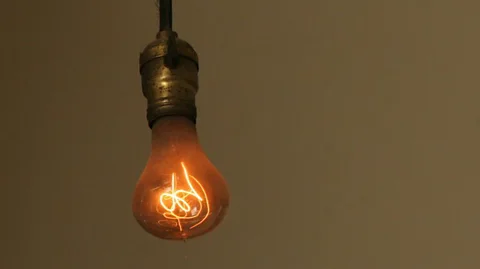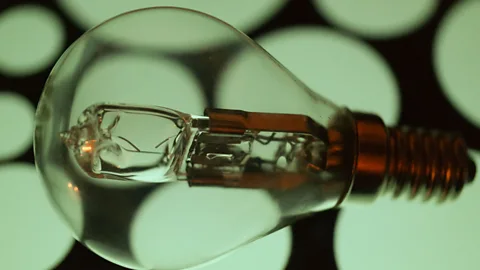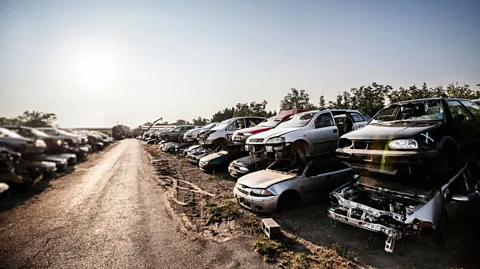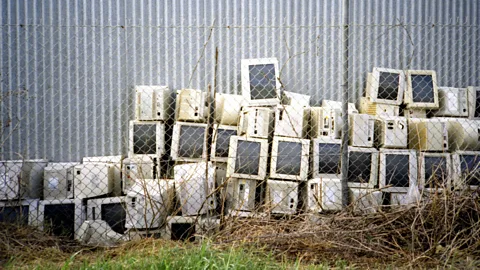It’s widely held that certain gadgets, cars and other tech have deliberately short lifespans, to make you shell out to replace them. What’s the reality?
“They don’t make ‘em like they used to,” as the idiom goes. So it would seem for the Centennial Light. An astonishing, record-setting 115 years after someone first flipped it on, this light bulb is still faintly shining in a fire station in Livermore, California. (You can see it for yourself on a webcam that refreshes every 30 seconds.)
For the multiple generations of us who have since swapped out more burned-out light bulbs than we can remember, the Centennial Bulb’s longevity must seem like a slap in the face. Surely, if an incandescent bulb made with 19th Century technology can last so long, why not new-fangled, 20th and even 21st Century bulbs?
The Centennial Light is often pointed to as evidence for the supposedly sinister business strategy known as planned obsolescence. Lightbulbs and various other technologies could easily last for decades, many believe, but it’s more profitable to introduce artificial lifespans so that companies get repeat sales. “That’s sort of the conspiracy theory of planned obsolescence,” says Mohanbir Sawhney, a professor of marketing at Northwestern University.
So is this conspiracy theory true? Does planned obsolescence really exist?
 Bill Nale/Panoramio/Wikipedia
Bill Nale/Panoramio/WikipediaThe answer: yes, but with caveats. Beyond the crude caricature of greedy companies wantonly fleecing their customers, the practice does have silver linings. To an extent, planned obsolescence is an inevitable consequence of sustainable businesses giving people goods they desire. In this way, planned obsolescence serves as a reflection of a ravenous, consumer culture which industries did create for their benefit, yet were hardly alone in doing so.
“Fundamentally, firms are reacting to the tastes of the consumers,” says Judith Chevalier, a professor of finance and economics at Yale University. “I think there are some avenues where [businesses] are kind of tricking the consumer, but I think there are also situations where I might put the fault on the consumer.”
An illuminating example
Sticking with light bulbs as a product, they provide amongst the most emblematic case studies of planned obsolescence.
Thomas Edison invented commercially viable light bulbs circa 1880. These early, incandescent bulbs – the Centennial Light included – relied on carbon filaments rather than the tungsten that came into widespread use almost 30 years later. (Part of the reason the Centennial Light has persevered so long, scientists speculate, is because its carbon filament is eight times thicker and thus more durable than the thin, metal wires in later incandescent bulbs.)
Initially, companies installed and maintained whole electrical systems to support bulb-based lighting in the dwellings of the new technology’s rich, early adopters. Seeing as consumers were not on the hook to pay for replacement units, lighting companies therefore sought to produce light bulbs which lasted as long as possible, according to Collector’s Weekly.
 iStock
iStockThe business model changed, however, as the light bulb customer base grew more mass-market. Greater sums of money could be reaped, companies figured, by making bulbs disposable and putting replacement costs onto customers. Thus was born the infamous “Phoebus cartel” in the 1920s, wherein representatives from top light bulb manufacturers worldwide, such as Germany’s Osram, the United Kingdom’s Associated Electrical Industries, and General Electric (GE) in the United States (via a British subsidiary), colluded to artificially reduce bulbs’ lifetimes to 1,000 hours. The details of the scam emerged decades later in governmental and journalistic investigations.
“This cartel is the most obvious example” of planned obsolescence’s origins “because those papers have been found,” says Giles Slade, author of the book Made to Break: Technology and Obsolescence in America, a history of the strategy and its consequences.
The practice cropped up in all sorts of other industries, too. For instance, competition between General Motors and Ford in the fledging 1920s auto market led the former to introduce the now-familiar model year changes in its vehicles. GM had pioneered a way to entice customers to splurge on the latest, greatest car, to satisfy themselves and impress those in their social circles. “It was a model for all industry,” says Slade.
Although the term “planned obsolescence” didn’t enter common usage until the 1950s, the strategy had by then permeated consumerist societies.
Alive and well
In various forms, from subtle to unsubtle, planned obsolescence still very much exists nowadays. From so-called contrived durability, where brittle parts give out, to having repairs cost more than replacement products, to aesthetic upgrades that frame older product versions as less stylish – goods makers have no shortage of ruses to keep opening customers’ wallets.
 iStock
iStockFor a fully modern example, consider smartphones. These handsets often get discarded after a mere couple years’ use. Screens or buttons break, batteries die, or their operating systems, apps, and so on can suddenly no longer be upgraded. Yet a solution is always near at hand: brand new handset models, pumped out every year or so, and touted as “the best ever”.
As another example of seemingly blatant planned obsolescence, Slade mentions printer cartridges. Microchips, light sensors or batteries can disable a cartridge well before all its ink is actually used up, forcing owners to go buy entirely new, not-at-all-cheap units. “There’s no real reason for that,” Slade says. “I don’t know why you can’t just go get a bottle of cyan or black [ink] and, you know, squirt it into a reservoir.”
Taken this way, planned obsolescence looks wasteful. According to Cartridge World, a company that recycles printer cartridges and offers cheaper replacements, in North America alone, 350 million (not even empty) cartridges end up in landfills annually. Beyond waste, all that extra manufacturing can degrade the environment too.
A nuanced view
Though some of these examples of planned obsolescence are egregious, it’s overly simplistic to condemn the practice as wrong. On a macroeconomic scale, the rapid turnover of goods powers growth and creates reams of jobs – just think of the money people earn by manufacturing and selling, for instance, millions of smartphone cases. Furthermore, the continuous introduction of new widgets to earn (or re-earn) new and old customers’ dough alike will tend to promote innovation and improve the quality of products.
As a result of this vicious, yet virtuous cycle, industry has made countless goods cheap and thus available to nearly anyone in wealthy Western countries, the Far East, and increasingly so in the developed world. Many of us indulge in creature comforts unimaginable a century ago.
 iStock
iStock“There’s no doubt about it,” says Slade, “more people have had a better quality of life as a result of our consumer model than at any other time in history. Unfortunately, it’s also responsible for global warming and toxic waste.”
Oftentimes, planned obsolescence isn’t nakedly exploitative, as it benefits both the consumer and the manufacturer. Chevalier points out that companies tailor the durability of their goods per customer’s needs and expectations. For instance: children’s clothing. “Who buys super durable clothes for their kids?” Chevalier asks. Depending on their age, children might grow out of their clothes sometimes in mere months. It’s not so bad, then, that the clothes might relatively easily stain, tear, or go out of style, so long as they’re inexpensive.
The same argument can apply to consumer electronics. Relentless innovation and competition for market share means that the underlying technologies in smartphones, for instance, keep surging ahead, with faster processors, better cameras, and so on.
“If ever there was true obsolescence, it’s in technology,” says Howard Tullman, a serial entrepreneur and chief executive officer of 1871, a digital startup incubator. “It’s almost as if the technology takes care of itself – this will obsolete itself whether you like it or not.”
Many owners might therefore appreciate paying less for a smartphone upfront whose, say, batteries can no longer hold a useful charge in three years. “Because the technology is evolving so rapidly, many people are not going to value the extra lifespan of a more durable battery,” says Chevalier.
A revealing counter-perspective to this nexus of customer desire and affordability mediated by planned obsolescence is the luxury goods market. Customers will opt to pay a substantial premium for products that often have finer craftsmanship, greater durability, and resale value – heck, many luxury goods consumers expect their investment to increase in value over time, instead of falling apart and being eventually rubbished. “If you buy a Rolex, you know it’s going to last you and you expect to be able to drive a truck over it,” says Slade.
Of course, people don’t just binge on a Rolex so it’ll be the last watch they or their grandchildren ever need to buy. To varying degrees, high-end brands serve to stroke clients’ egos as symbols of elevated social status. “Luxury goods are socially coded,” says Slade.
 Getty Images
Getty ImagesAs the years go by, though, hallmarks of a luxury version of an item can work their way into the mass market as their production grows cheaper and customers come to expect the perks. Few would argue that the increased availability of safety devices, like air bags in cars, once only found in pricier models, has not been a net positive. So in its admittedly self-interested, halting way, the competition at the heart of planned obsolescence-influenced capitalism can work in looking out for consumer’s interests as well.
The future of obsolescence
Accordingly, though examples clearly exist to the contrary, some business academics feel that it’s a bit over the top to assume many companies sit around plotting how to precisely engineer a product to self-destruct.
“If you have a market that’s kind of competitive, then the expected lifespan of the product is certainly something the firms compete over,” says Chevalier. “For a lot of products it’s not like consumers aren’t savvy enough to try to choose products that won’t [soon] be obsolete.”
Indeed, there are forces that could encourage manufacturers to lengthen lifespans.
In the auto market, Chevalier says “everybody thinks about and looks up how quickly does this car depreciate relative to others”. Indeed, in this arena, cars now stay on the road longer than they once did.
“The auto industry for years has been sort of a fashion-driven business, where your car had fins and five years later, fins were out of style,” says Tullman. Yet that’s changing: he cites United States Department of Transportation figures showing that the average age of a passenger vehicle on the road in that country now stands at 11.4 years; in 1969, the figure was 5.1 years.
With internet reviews, it’s easier than ever to find out if your intended purchase has a short lifespan – and that goes for lightbulbs as well as cars.
And as environmental consciousness of the terrible amounts of waste generated by a throwaway culture has risen, consumer goods might become less disposable. Google’s Project Ara, for instance, is developing a smartphone-like device with six slots for swapping out technologically outdated components, versus traditionally binning the entirety of an aging smartphone.
A business-minded approach to smarter recycling, reuse and repurposing has arguably made a big dent and will so in future, says Sawhney. For instance, Tesla, the electric automobile manufacturer, has plans to take back the spent batteries in its clients’ cars and repurpose them for home energy storage. The company also auto-downloads and upgrades the software in its clients’ cars as the vehicles charge overnight. Sawhney, who is a Tesla owner, says the company planned ahead for these sorts of upgrades by including “basically future-proof” sensors and hardware in the vehicle.
“Instead of selling model after model of the car to me, [Tesla] just changed the software,” Sawhney says. “So that’s an antidote to planned obsolescence in a way – it makes obsolescence obsolete.”
--
Join 600,000+ Future fans by liking us on Facebook, or follow us on Twitter, Google+, LinkedIn and Instagram.
If you liked this story, sign up for the weekly bbc.com features newsletter, called “If You Only Read 6 Things This Week”. A handpicked selection of stories from BBC Future, Earth, Culture, Capital, Travel and Autos, delivered to your inbox every Friday.


Post a Comment